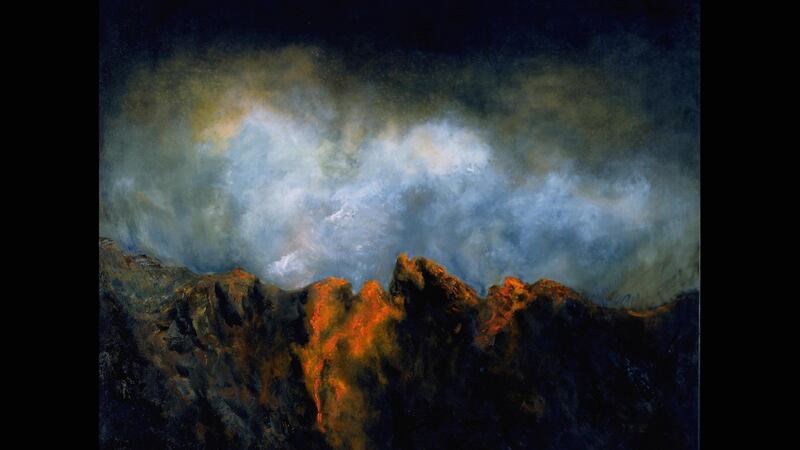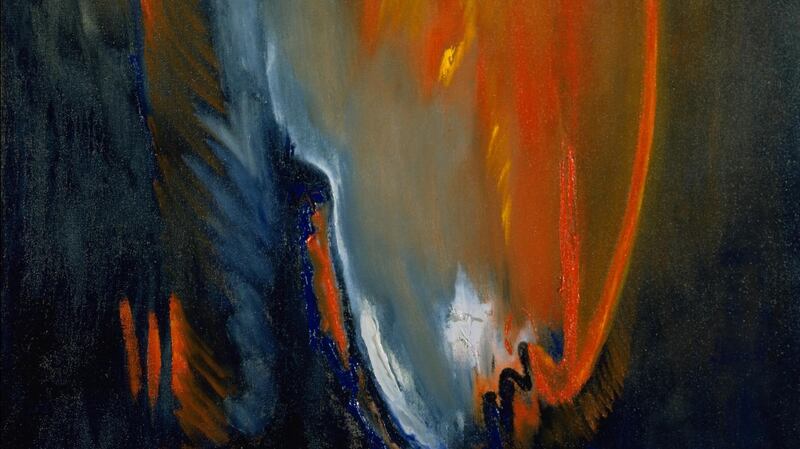Of all the earth’s natural phenomena, volcanoes are perhaps the most aesthetically appealing – and the most nakedly terrifying. Google them and you’ll find an array of images which convey their power and majesty. These shots, however, have been taken with a high-resolution camera, and from a considerable distance. Who would be mad enough to get up close and personal with a volcano, in order to portray it in oil on canvas?
Carmel Mooney, is the answer. The Kilkenny-born landscape painter has spent more than 20 years scrambling across the lava-strewn foothills of Mount Etna in Sicily and the desolate expanses of the Fire Mountains in Lanzarote, notebook in hand, making detailed sketches which she later transforms into dramatic paintings of eruptions, flows, crater edges and great gashes in the surface of the planet.
Mooney has a very particular view of volcanoes: but how would that view look to a volcanologist? Ahead of her exhibition From Earth To Fire at the Italian Cultural Institute – her first solo show in a decade – we asked Dr Eoghan Holohan, lecturer in earth sciences at UCD, to speak to the artist and take a look at her work.

Holohan has also devoted much of the past 20 years to the study of volcanoes. So when the pair get together at Mooney’s home in Ballsbridge, I begin by asking both of them why they love volcanoes. “They’re exciting, they’re dynamic and they fundamentally affect the way the world works,” says Holohan. “I don’t know that I love volcanoes,” Mooney says. “But they’re a huge challenge to paint.”
They’re also, it turns out, a huge challenge to science.
“A scientist will try to reduce things down to bits we can understand – but volcanoes are really complex systems, so trying to predict their behaviour is really difficult,” Holohan explains. The only way to learn more about them is by sustained and meticulous observation – which, of course, is also how Mooney researches her paintings.
She has even flown over Mount Etna in order to see right into the crater – a dangerous enterprise, and an uncomfortable one for somebody who says she hates heights. “But you’d be hypnotised, looking down,” she says. “The dazzling white smoke, the jet black, the blue-black, the yellow, the reds, the pinks . . .” And that was when there was nothing much happening, geologically speaking.

Holohan nods. He recalls a visit to the island of Réunion in the Indian Ocean, three years after the volcano Piton de la Fournaise had erupted.
“The lava had cut a road, which we walked on. It was solid rock, but it was still unbelievably hot – you could put your hand on it, but you wouldn’t leave it there for very long.”
Mooney remembers being told by a guide at the big crater in Lanzarote that it was “fire trapped in the upper layers of the earth”.
“Ah, that was a very poetic way of putting it,” says Holohan. “It’s just heat.”
Mooney clearly has an affinity with fire: she spends a good deal of time working in the furnaces of Murano, in Venice, creating glass sculptures. The spectacular colours she uses in her work, however, have as much significance – if somewhat different emphasis – for scientists as they do for an artist.
“There’s a lot of iron in the rock, so you get various rusting effects, from brown to bright red,” says Holohan. “The yellow is sulphur. The colour of the rocks tells you about the components in those rocks and also, in turn, about how the rocks were formed and what’s going on deep in the earth through time.
“Geological maps are all about colour. For a geologist, a map needs to be accurate. But a really good map is also beautiful to look at. The choice of the colour palette, the quality of the line work, the drawings – all are important.”
Mooney also regards her work as documenting the state of these wild places, stressing that the shape of, say, the edge of Mount Etna will differ from one year to the next. Although they never figure in her paintings she’s also very interested in the people who live near volcanoes, and how they cope with the uncertainty – as well as the fertility – of the landscape.
There isn’t space here to give a full picture of the wide-ranging conversation between artist and scientist – suffice to say that they get on like, well, like a volcano on fire. They exchange stories and trade statistics.
“Lava from Mount Etna travels at 4km an hour,” says Mooney. “You can outrun it – if you’re in good shape.”
“Pyroclastic flow can be up to 400km an hour,” returns Holohan. No outrunning that, then.
The volcanologist is impressed by the heat and movement conveyed by Mooney's paintings – so much so, that he asks her permission to use one of them, From The Dark Earth I, as an example in his lectures next term. He hopes it will move and inspire a new generation of geologists. We reckon that as reviews go, that's a pretty good one.
Carmel Mooney: From Earth To Fire is at the Italian Cultural Institute on Fitzwilliam Square East, Dublin, until July 13th.












